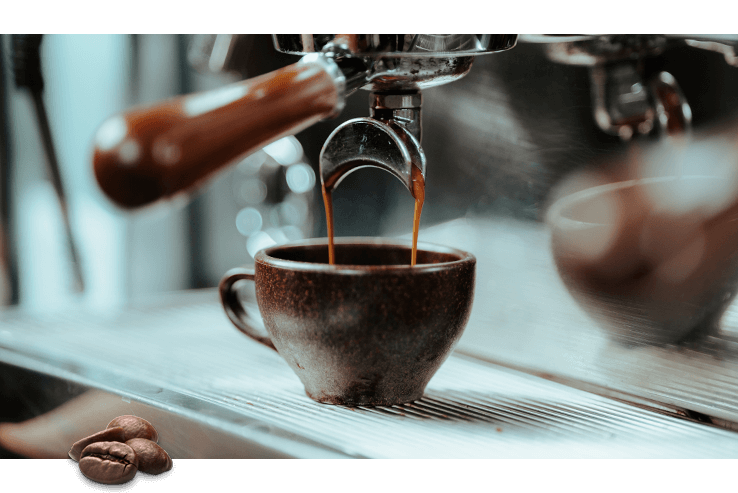Comprehending Coffee Beans: the Trip From Coffee to Blended Coffee Beans

The Origins of Coffee: A Global Viewpoint
While you may think about coffee as a contemporary staple, its origins trace back centuries, linking with societies around the world. The story starts in Ethiopia, where legend claims a goat herder called Kaldi found the invigorating impacts of coffee beans after noticing his goats romping energetically after eating them. This sparked passion, bring about coffee's spread to Arab investors who valued the brewed drink. By the 15th century, it got to Persia, Egypt, and Turkey, where coffeehouses came to be social centers for conversation and society.
As trade paths increased, coffee made its means to Europe in the 17th century, swiftly acquiring appeal. It changed from a mystical beverage into an everyday routine, motivating events and intellectual exchanges. Each society included its special spin to coffee preparation, improving its history. This international journey highlights exactly how coffee connects us, going beyond borders and unifying diverse practices with a simple bean.
Cultivation and Harvesting of Coffee Beans
As coffee's journey advanced, the focus changed to the farming and harvesting of certain bean varieties, particularly those made use of for espresso. You'll locate that espresso beans typically come from Arabica or Robusta plants, each offering unique flavors. The suitable growing conditions consist of high elevations and abundant, well-drained soil, which enhance the beans' quality.
During the harvest, picking methods differ. In some areas, workers hand-pick ripe cherries, making sure only the finest fruit goes to processing. In various other locations, mechanical farmers are made use of, particularly on larger farms. Timing is important; you wish to gather when the cherries reach peak ripeness for optimum flavor.
When gathered, the beans are gotten ready for processing, which is crucial in determining their final taste. Comprehending the farming and harvesting procedures gives you understanding right into what enters into your preferred coffee, enhancing your recognition for each mug.
Processing Methods: From Cherry to Bean
Now that you've found out about gathering coffee beans, allow's explore just how those cherries transform right into the coffee beans you like. You'll see just how different harvesting methods impact taste, followed by the essential actions of fermentation and drying out. Finally, we'll damage down the milling and grading procedure that identifies your coffee's top quality.
Harvesting Strategies Described
When it comes to coffee, comprehending harvesting strategies is vital, since they straight impact the taste and high quality of the beans you enjoy. Careful picking includes hand-picking just ripe cherries, ensuring you obtain the finest top quality beans. Inevitably, the selection of harvesting technique can considerably influence your coffee experience, so it's worth understanding exactly how those beans made it to your cup.
Fermentation and Drying Out
After collecting, the next action in processing coffee beans play a significant duty fit their taste. You'll find that fermentation is important, as it helps damage down the mucilage bordering the beans, improving their taste profile. Relying on the approach, this process can last from a couple of hours to a number of days, with varying outcomes based upon temperature and moisture.
When fermentation is complete, drying out complies with, which is similarly important. You can pick from sun-drying or mechanical drying out approaches. Sun-drying permits the beans to absorb flavors from the atmosphere, while mechanical drying out guarantees regular wetness degrees no matter of climate. Proper drying is necessary to avoid mold and maintain the beans' top quality, inevitably affecting your cup of coffee.
Milling and Grading Process
As fermentation and drying out established the phase for taste growth, the milling and grading procedure warranties that just the ideal coffee beans make it to your cup. This stage includes getting rid of the outer layers of the coffee cherry, consisting of the parchment and husk. Premium beans obtain a higher quality, resulting in a richer coffee experience.
Roasting Techniques: Opening Flavor Possible
When you roast coffee beans, the method you choose can substantially influence the taste profile. Recognizing the connection between time, temperature, and toasting strategies is essential to revealing the capacity of your mixture. Allow's discover how these aspects integrated to create the excellent mug.
Roasting Techniques Explained
While you might think that all coffee toasting techniques yield the exact same results, the reality is that each strategy reveals one-of-a-kind flavor possibilities in the beans. Drum roasting makes use of a rotating drum to equally distribute warmth, enhancing caramelization and creating a balanced flavor. Air roasting, on the other hand, circulates hot air around the beans, advertising a lighter roast with pronounced level of acidity.

Effect On Flavor Account
Different toasting approaches not only affect the procedure however also substantially affect the taste account of the coffee beans. When you choose a light roast, you'll experience brilliant acidity and flower notes, showcasing the bean's origin. In contrast, a tool roast balances acidity with sweet taste, frequently disclosing chocolatey undertones. Dark roasts, on the other hand, highlight bold, smoky flavors, often masking the bean's distinct features. Each technique exposes various oils and compounds, resulting in a wide variety of flavors. By try out numerous toasting styles, you can discover which profiles resonate with your taste buds. Recognizing these subtleties helps you appreciate the artistry behind your cup of coffee, improving your general experience with every sip.
Time and Temperature Level Elements
To launch the complete taste possibility of coffee beans, both time and temperature throughout the roasting process play substantial roles. When toasting, you'll discover that greater temperatures can swiftly establish flavors, but if you rush it, you may finish up with charred notes. Alternatively, reduced temperature levels enable an extra steady flavor advancement, showcasing the beans' one-of-a-kind attributes.

Timing is just as crucial; extending the roast also long can lead to a loss of level of acidity and brightness, while also short a roast might leave the beans underdeveloped. Discovering that sweet area calls for practice and trial and error. By changing these elements, you can reveal the abundant, intricate flavors concealed within each bean, developing a truly exceptional coffee experience.
The Art of Mixing: Crafting Special Coffee Profiles

Beginning by choosing a base coffee that gives a solid structure. A brilliant Ethiopian bean can bring fruitiness, while an abundant Brazilian coffee includes body.
As you mix, remember that each mix tells a tale. You're not simply making coffee; you're producing an experience. So, take your time, preference often, and delight in the trip of uncovering your trademark mix.
Brewing Techniques: Exactly How Preparation Affects Flavor
Mixing coffee opens up a domain name of taste opportunities, yet how you make that blend can considerably affect your final mug. On the other hand, a pour-over highlights the coffee's quality and illumination, perfect for showcasing fragile notes.
Espresso, with its high stress, produces a focused shot that accentuates sweet taste and crema. If you choose a lighter mixture, take into consideration a chilly mixture approach; it yields a smooth, much less acidic preference.
Eventually, testing is crucial. Changing variables like water temperature, grind dimension, and make time can change your coffee's account. So, embrace the art of brewing to uncover the flavors hidden in your coffee blends. The right method can boost your experience to brand-new elevations.
The Future of Coffee: Sustainability and Technology
As the coffee market advances, sustainability and technology are coming to be crucial for dealing with environmental obstacles and conference customer needs. You'll see that even more coffee business are taking on environmentally friendly techniques, from sourcing beans ethically to executing sustainable farming strategies. These changes not Click This Link only help the planet however likewise enhance the top quality of the coffee you delight in.
You might see developments like eco-friendly product packaging and water-saving brewing approaches that minimize waste. Advanced technology, such as blockchain, is also ending up being prominent, making certain openness in the supply chain, which permits you to map your coffee back to its beginnings.
Furthermore, buying local neighborhoods and sustaining farmers via reasonable profession initiatives fosters a much more lasting coffee community. As you drink your next cup, bear in mind that your choices can contribute to a brighter future for coffee. By deciding for lasting brand names, you're not just taking pleasure in a beverage; you're making a positive impact on the globe.
Regularly Asked Concerns
What Is the Distinction In Between Arabica and Robusta Beans?
Arabica beans are smoother, sweeter, and have a higher level of acidity, while robusta beans are more powerful, a lot more bitter, and include more high levels of caffeine. When brewing your coffee., you'll observe these differences in flavor and fragrance.
How Does Elevation Affect Coffee Bean Flavor?
Altitude impacts coffee bean taste considerably. Higher elevations produce beans with brighter acidity and complex tastes, while lower altitudes usually produce beans that are much heavier and much less nuanced. You'll observe these differences in your mug!
What Are the Health And Wellness Perks of Alcohol Consumption Coffee?
Consuming coffee can boost your power, improve mental emphasis, and even boost physical efficiency. It's rich in anti-oxidants, might lower the threat of certain illness, and can promote a healthier metabolic rate when consumed in moderation.
Can Coffee Beans Be Recycled for Brewing?
Yes, you can recycle coffee beans for brewing, yet the flavor could be weak. If you delight in trying out, attempt recycling them in different ways, like cool brews or including in shakes for an extra kick.
Exactly how Should I Store Coffee Beans for Quality?
To maintain your coffee beans fresh, save them in an airtight container in a great, dark place. Avoid subjecting them to light, moisture, or warm, as these variables can rapidly weaken their flavor and aroma.
Recognizing Coffee Beans: the Trip From Espresso to Blended Coffee Beans.
Now that you've found out concerning collecting coffee look at this web-site beans, allow's discover exactly how those cherries change right into the coffee beans you like.When you roast coffee beans, the technique you choose can drastically impact the taste profile - Single Origin Espresso.While you might assume that all coffee roasting techniques generate the exact same outcomes, the fact is that each technique reveals one-of-a-kind taste capacities in the beans.Various roasting methods not just influence the process but additionally substantially affect the flavor account of the coffee beans